Las Vegas American Legion displays war artifacts, uniforms
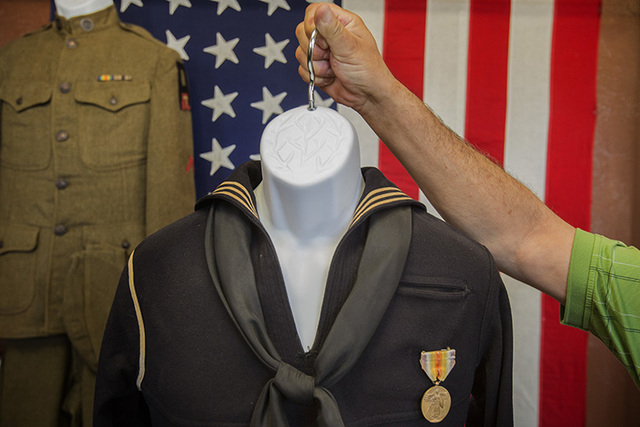
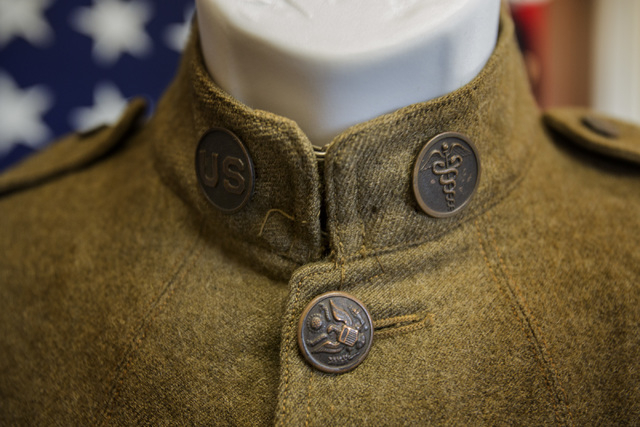
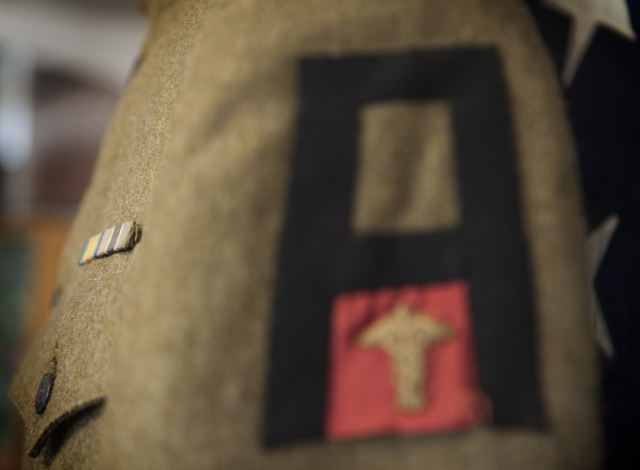
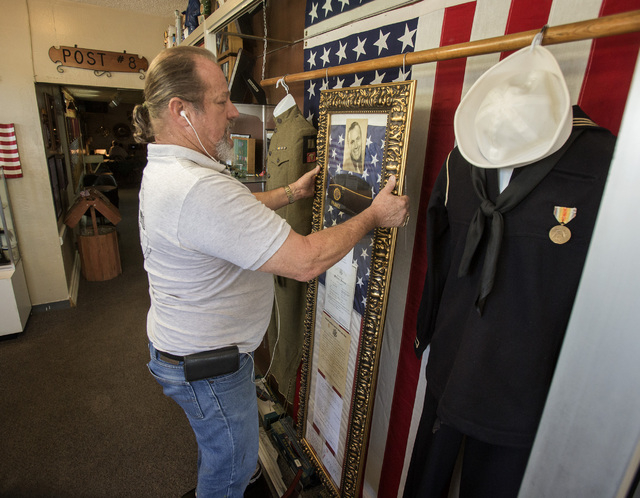
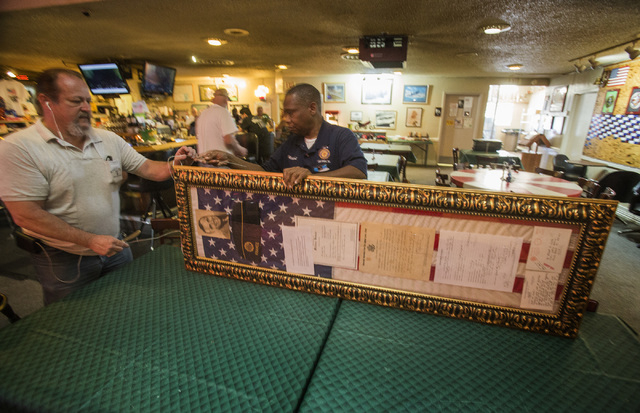
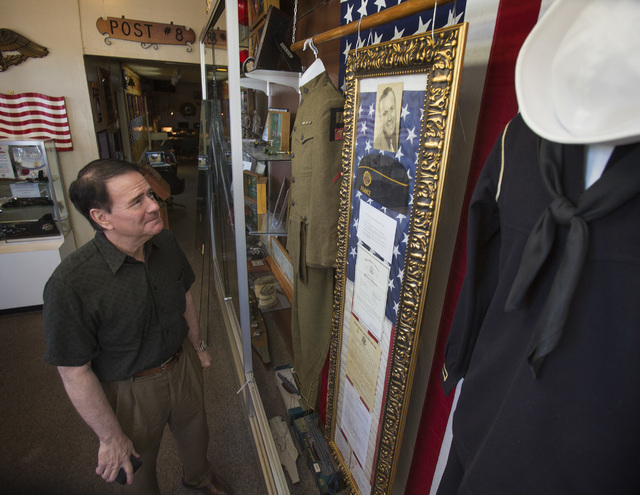

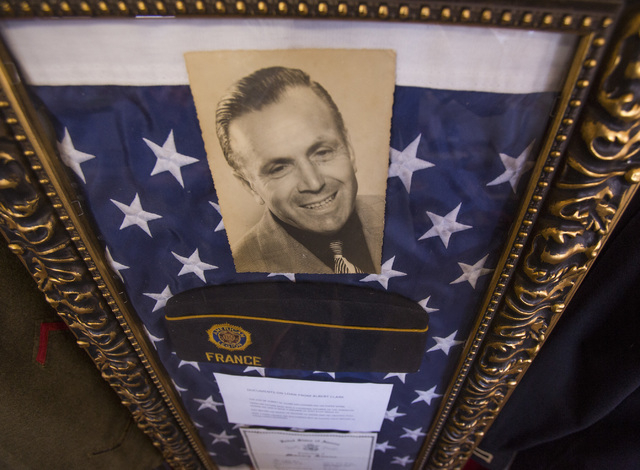
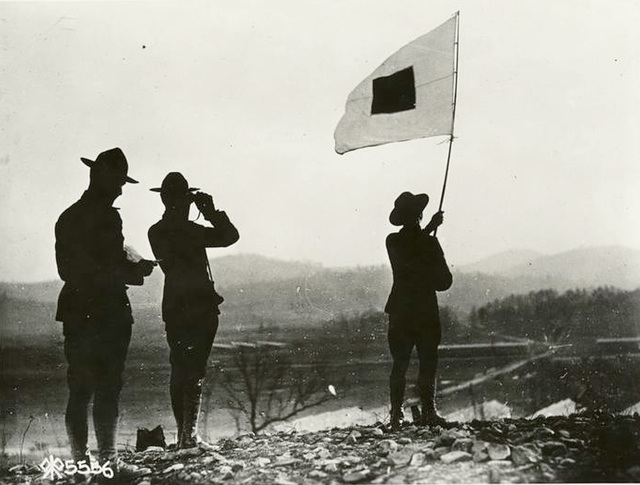
Nearly 100 years after World War I began, the blue wool cap with the word “France” sewn in gold thread rests below a picture of the man who wore it.
Albert M. Clark’s rare American Legion Post 1 garrison cap is on display in Las Vegas today and indefinitely along with his honorable discharge paper signed in fountain-pen ink by Maj. James J. Tyson on May 28, 1919.
That was the year that Clark and his Army buddies formed the first post in Paris “to honor the service records of American soldiers, especially the ones killed in World War I,” said his son, Albert Clark, of Las Vegas.
“He once told me that he was involved with a bunch of guys that stayed in France after the war. They were going to coffee shops and different places in Paris … and he wanted their memory never to be forgotten,” he said about the roots of the American Legion.
“I’m one of the few actual sons of a World War I veteran,” he said, adding that his father was born in 1896 but had children late in life, at age 57.
Fittingly, his father’s items are on display with two World War I uniforms worn by soldier-and-sailor brothers whose family donated them to Nevada’s American Legion Post 8 about five years ago. Post 8 also was established in Las Vegas in 1919, the year after the “war to end all wars” ended.
Said Post 8 Commander Rod Carlone: “There was a Post 8 at the same time there was a Post 1 in Paris, France. So, it’s kind of like the whole American Legion coming together and meeting here in Las Vegas, which is kind of neat.”
“You have a lot of senior members here, and I’ll tell you, the more it means to have these sort of artifacts especially to be able to put it on display,” he said.
“Not only the veterans themselves, but the sons and daughters of veterans are focusing more on what their fathers, their mothers, their grandfathers did. And coming in here, they’ll get a glimpse of what it looked like. This is what they wore, how they looked and and this is what the paperwork, the documentation looked like from that era. We’re talking almost 100 years here,” Carlone said
He noted that Post 8’s war relics collection includes Pvt. George Peters’ Medal of Honor from World War II after “decades of being hidden, and then rediscovered. What we have here is a compilation of things that every veteran can identify with.”
OVER THERE
Albert Clark decided to loan his father’s World War I items for display in time for the Fourth of July as the nation’s marks 238 years of independence and freedom from British rule. Ironically, the British would be allies in the world wars that followed.
“Independence Day for Americans means that they were free, and we don’t have any outside forces interfering with us and we’re free to speak our own mind,” Clark said. “And liberty is very important in our lives because if you go to any other countries, they don’t have the same freedoms that we have in this country.”
While fighting for freedom since the Revolutionary War has been the American way, Clark noted that the United States was a hesitant, late-comer in World War I.
“My father spoke about the sentiment in the U.S. was not to join the war. The war started in 1914 and we did not get actively involved until 1917,” said Clark.
War erupted in Europe 100 years ago, on July 28, 1914, when Austria-Hungary forces invaded Serbia one month after Archduke Franz Ferdinand was shot and killed along with his wife by a Yugoslav nationalist, Gavrilo Princip, in Sarajevo. Germany, siding with Austria-Hungary, began an invasion through Belgium and Luxembourg aimed at France, which prompted Britain to declare war on Germany.
What followed was four years of warfare on land and sea with soldiers and sailors fighting from trenches, ships and submarines with the gamut of weapons — rifles, bayonets, machine guns, mortars, torpedoes, tanks with rhomboid tracks, early aircraft, artillery guns, poisonous gas and horse-drawn cannons. One of those cannons sits near the flag pole at Post 8 and greets all visitors. With wooden-spoke wheels since removed, it was donated to the post by the French government.
Germany’s deployment of U-boats, or “underwater boats” — submarines that fired self-propelled torpedoes — to attack U.S. merchant ships eventually drew the United States into the fray in April 1917 — two years after 128 U.S. citizens were killed when a U-boat sank the British passenger ship, RMS Lusitania, on May 7, 1915.
Adding to the international powder keg that prompted Congress to declare war on Germany on April 6, 1917, was a telegram from Germany’s foreign minister to the Mexican government offering Mexico to become Germany’s ally. In exchange, Germany would fund Mexico’s war effort to recover Southwest territorial lands that had become the states of Arizona, Texas and New Mexico.
After British intelligence intercepted the so-called Zimmerman Telegram, it was shared with the U.S. embassy and peace-loving President Woodrow Wilson who released it to the American public.
Congress rallied to the war cause, approving legislation to draft young men, nearly 3 million in all, with 10,000 a day descending on France in 1918.
BROTHERS IN ARMS
Among those who registered for the draft, and signed up for the Navy, was James Earl Heckel, a chauffeur from Youngstown, Ohio, born Dec. 20, 1895. Another young man named Heckel from Youngstown, steelworker Thomas Edgar Heckel, born Feb. 3, 1900, also entered the draft, according to hand-written World War I draft registration records.
Today, Pfc. Thomas E. Heckel’s thick wool, olive-drab tunic and trousers with laces for canvas, “doughboy” leggings flank the Clark World War I display at American Legion Post 8. On the other side is the Navy blue “crackerjack” uniform of Seaman James E. Heckel, according to past Post 8 Commander Cliff Adele, who accepted them “four or five” years ago from a now-deceased post member, who he described as the soldier’s great grandson and the sailor’s great nephew.
Adele said that the man, a Vietnam War veteran whose name he can’t remember, had inherited the items from his mother and aunt’s side of the family. Stowed for decades in a footlocker, they had been hauled westward as his relatives moved from the Youngstown area near the Ohio-Pennsylvania state line, to Colorado, and finally when he came to Southern Nevada.
“The uniforms smelled so bad. They had been packed in mothballs. I had to burn candles in the office to keep the odor down,” Adele said Tuesday.
Little is known about the Heckels’ role in the Great War. The back of a black-and-white group photograph of sailors in Company 804 identifies James E. Heckel as No. 18, standing in the back row. That photo is on display along with photos of an unnamed World War I soldier and the field artillery unit he served with after the war in the 1920s at Fort Logan, Colo.
While it is unclear what unit Pfc. Thomas E. Heckel was in during the war, the shoulder patch on the left sleeve of his uniform is a black, Gothic “A,” with the legs of the “A” straddling a red background and the Greek mythology “caduceus” symbol of serpents intertwined around winged staff. This patch indicates he served in the First Army’s Medical Department.
The Army service of Clark’s father has more detailed documentation. He was born in Sacramento, Calif., and enlisted in the Army at 22 after being an assistant cashier in civilian life with prior service from late 1917 to early 1918 in the Signal Enlisted Reserve Corps. Army records show he served in France with the 104th Field Signal Battalion of the 29th Division about the time the armistice was signed on Nov. 11, 1918. While this resulted in a cease-fire on the Western Front, fighting continued in other regions.
DOUGHBOYS AND TRENCHES
Albert Clark said his father “told me stories about some of the sights he’d seen” but said little about his combat experience. “But World War I … they were using gas and they were in the trenches and it was a very dangerous situation.”
The 104th Signal Battalion was deployed in France on the Verdun-sur-Meuse Front from September through November 1918. Thirteen enlisted men in the 104th Field Artillery Battalion were killed in action, died of wounds, or died of disease.
“The signal corps, the only way that it could (secretly) communicate between soldiers on the line they had to lay wire because the radios were not sophisticated enough that they were wireless,” Clark said. “They actually had to run wire between the trenches and the signal corps responsibility was to lay that wire. Of course with bombardments constantly from artillery and gas and all that it was a very hazardous situation.”
Albert Clark Sr. was honorably discharged at Camp Dix, N.J., near the end of May 1919. After the war he built small hotels in Miami and later owned American Rubber Corp., a rubber tile company in Albeterville, Ala., which was named in his honor.
During the 1960s he owned a die-casting company in Miami that produced hand-grenade components for the Army.
He died in 1986 at age 91. He left his original American Legion cap with his son who is proud to display it because “I wanted to show he was an actual veteran of World War I.”
Contact Keith Rogers at krogers@reviewjournal.com or 702-383-0308. Find him on Twitter: @KeithRogers2.












